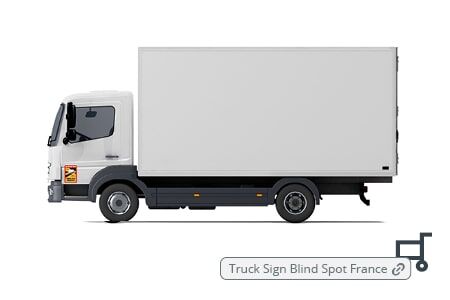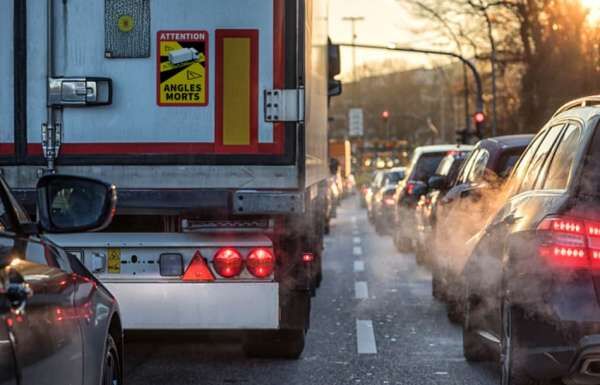“Angles morts” literally translates as “dead angle” and refers to the blind spot, the area that is not covered by looking into the side mirrors or through the side windows, that drivers are not able to see. Especially drivers of big vehicles like trucks and buses usually have a more limited view of the area around their vehicle due to the size of the vehicle, often missing rear windows and the higher seating position. When turning or changing lanes they can easily miss objects or other road users in their vicinity leading to accidents – many of them lethal.
To reduce the risk of blind spot accidents, the French Government published a new legislation, based on article L313-1 code de la route, which was introduced on 1st January 2021. The French highway code states that all vehicles with an authorised total weight of more than 3.5 tonnes going through build-up areas in France are required to use warning signs to make other road users aware of the potential danger. The law primarily aims to improve the safety for pedestrians, cyclists and other very vulnerable road users.
Which Vehicles Need Blind Spot Signs?
All vehicles, coming from inside or outside EU, going through urban areas like cities, towns and villages in France and exceeding a GVWR of 3.5 tonnes need to be equipped with blind spot signs. That includes commercial vehicles transporting goods such as trucks and lorries, motor vehicles with trailers or semi-trailers or vehicles transporting passengers such as coaches and buses as well as private vehicles like caravans and motorhomes.
Exempt from this rule are:
- agricultural and forestry vehicles
- winter service vehicle
- road maintenance vehicles on highways or roads with two separate carriageways
- motor vehicles and trailers that due to their body construction do not allow the application of such signs
Please note that an installed side camera does not exempt from having the blind spot signs. The fee for non-compliance usually is around 135 €.
Where and how are the Blind Spot Signs Applied?
Each vehicle is to be equipped with 3 blind spot signs: one on each side and one on the rear at the right side. Two official versions were published by the Ministry of Ecological Transition. The 17 x 25 cm signs show either a truck (used for HGVs) or a bus (used for passenger transport vehicles). The signs are to be applied at a height between 0.90 m and 1.50 m above the ground. If requirements regarding the position cannot be met exactly due to the structure of the body, the signs must be placed as close as possible to that indication but not higher than 2.1 m above the ground. It is also important that the signs are visible at all times and do not cover any other signs and plates or lights on the vehicle.
The warning signs can be applied as stickers, as rigid signs with screws or by other means of fixation. In our shop we have a range of different versions including: self-adhesive stickers, aluminium plates, reusable adhesive signs, magnetic signs and Impex® plates with suction cups.
Blind Spot Signs on Trucks and Trailers
Trucks and haulers, trailers and semi-trailers need to be equipped with 3 
 The signs on the left and right are positioned as follows:
The signs on the left and right are positioned as follows:
- Trucks: within the first metre from the front of the bodywork (excluding windows)
- Trailers: within the first metre from the front of the trailer
- Semi-trailers: within the first metre behind the kingpin
If requirements regarding the position cannot be met exactly due to the structure of the body, the signs must be placed as close as possible to that indication but not more than 3 metres from the front of the vehicle.
A truck with a trailer or semi-trailer might need up to six blind spot signs.
Blind Spot Signs on Buses and Motorhomes
Buses and coaches need to be equipped with 3 
Campervans and motorhomes of all kind also need to carry the blind spot sign for buses since they transport passengers. The application follows the same rules. Please note that there is no official sign with a motorhome symbol, the only two official signs show a truck or a bus. Nevertheless, you will find a slightly altered version of the bus sign in our shop.





 ATTACHMENT |
ATTACHMENT | 



